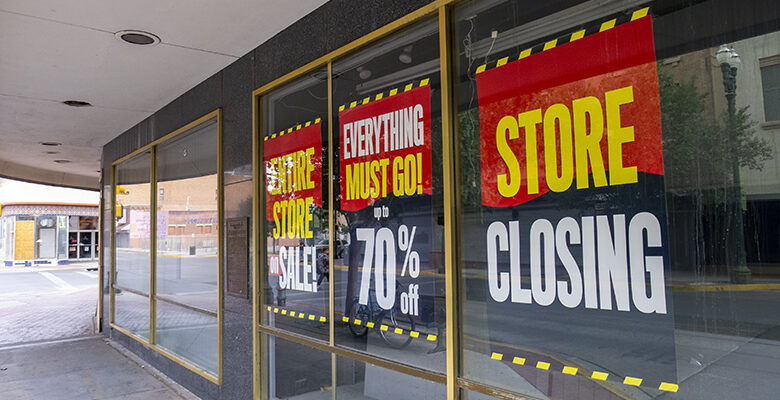The El Paso Times reports that the Fallas Department Store in DWNTWN is closing:
One of Downtown El Paso’s largest stores, which closed for just over a year during the COVID-19 pandemic, is in the process of closing permanently.
The Fallas discount department store at 301 E. San Antonio Ave., is in the midst of a going out of business sale.
Also, Food City in Fox Plaza:
Food City, an El Paso grocery store for nearly 60 years, announced Tuesday it is closing one of its three locations.
The Fox Plaza location, which opened 50 years ago in 1972, will close in August, store officials announced on its Facebook page. The stores are well known for their Mexican pastries, beef selection, flour tortillas, tamales and burritos.
I’m sure that if you look around El Paso, you can find failing businesses everywhere. The U.S. Census Bureau estimates that the population of El Paso fell by almost two hundred people last year.
But the City’s been paying a lot of attention to downtown. Downtown is supposed to represent El Paso’s renaissance.
The Cobbler, the shoe repair taller in that little niche in the Abdou Building, is out of business.
And the word on the street is that the CVS contraesquina to the Fallas at Mesa and Texas will soon be shutting its doors for good.
If you look around downtown El Paso, you see lots of opportunity. Lots of empty storefronts. Places where you, too, could pour your dreams and aspirations, your sweat and tears, your blood and money, and leave ruined as soon as your capital runs out. The dominant industry in downtown seems to be signature loan shops. They, at least, appear to be thriving.
If you subscribe to the Broken Windows Theory, you might notice that there are a lot of broken windows in the Caples Building. The three buildings at the intersection of Mesa and San Antonio are all empty, except for the Fallas which is going out of business. The fourth corner of that intersection is a vacant lot.
We used to complain that downtown El Paso was a ghost town after six o’clock, but now, thanks to the tireless efforts of El Paso City Government and the Downtown Management District, we’re even running off the businesses that used to thrive during the day.
And did you hear that the national economy is on the brink of a recession?
That should help.


A vibrant downtown means lots of people living and working there. That has not been the case in El Paso since, maybe the 1970’s. Yes, there are some people out and about when there is a baseball game in that little ball park, or an event at the Plaza Theater, or the Abraham Chavez theater. But, once those events are over, everybody goes home, don’t they. How does that sort of activity sustain a neighborhood?
Yeah, everybody goes home. I know that Suzy Byrd was a big advocate of DTEP precisely because she wanted the ambience of nightlife and clubs post-game here. But people go home. Where do people not go home and hang around for a club scene downtown? In cosmopolitan large cities, mostly. Right? Richard Florida’s “Creative Class” kind of places filled with hipsters and young urbanites socializing over wine and brie.
I was just in one of these in May when I traveled to San Francisco for the Bioneers conference that was held at the Palace of Fine Arts in the so-called “Marina District.” I stayed at an inn on Lombard Street, an easy walk to the conference. The streets are lined with bistros and coffee shops and packed with diners, mostly people in their 20s and 30s, I guessed. I assume it is even more so in in the North Beach area. Great food, friendly young people; I gained six pounds! A one-bedroom apartment in the area (above one of the bistros) goes for $3,500 per month.
So who are these people who don’t go home? Checking out the Census page : https://www.census.gov/quickfacts/fact/table/sanfranciscocitycalifornia,elpasocitytexas,US/PST045221
I see that SF is a lot more diverse – 34% Asian and 15% Hispanic. 59% have a bachelors degree or better versus 26% in El Paso (BTW, a huge improvement in the 26 years I have lived here). There are more people in the workforce, too, with 71% working versus 60% here. Per capita income is $72,000 versus $23,000 here.
In short, if you want people to stick around after work or the game, you’ll need to look more like the places where they do. But that is a two-sided coin because the median value of a single family home in SF is $1,152,300. There are other things about California, too, and my little side trip up to Mendocino had a very different demographic and vibe, like more lumberjacks and fisherman than software engineers and journalists.
If I had to make one statement about why people here go home, it would be that they have a family at home to go to.
It’s not surprising that retail not doing so well..unless you work downtown, or in a few cases live there, why would you drive downtown, search for parking, maybe pay $10-$15, or run into a “festival” and not get there….and shops for visitors in hotels are not the same kind of shops…